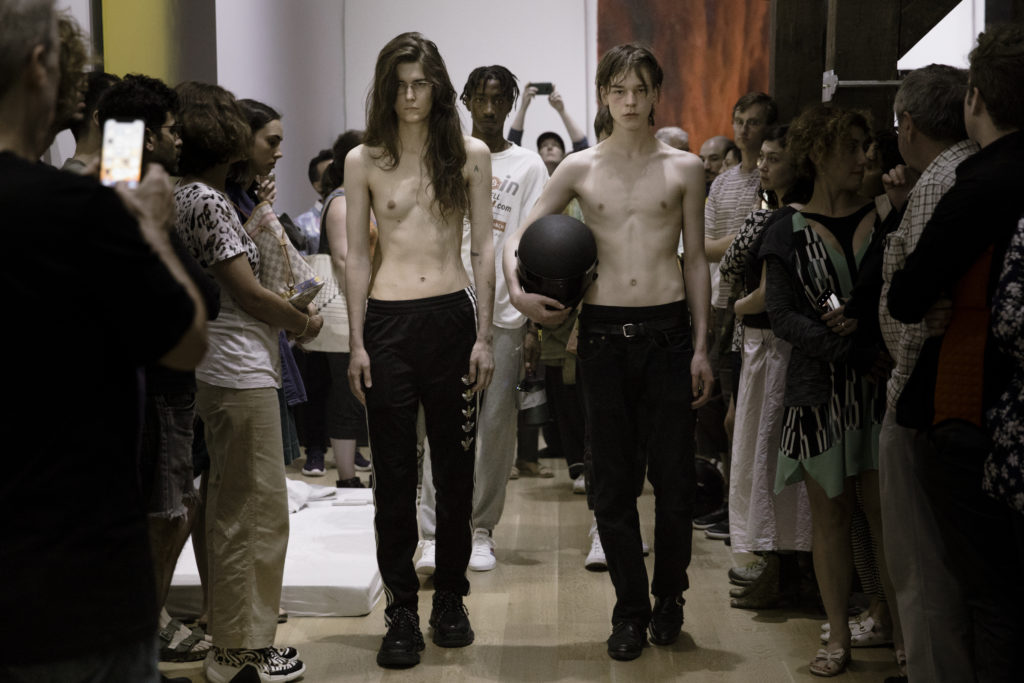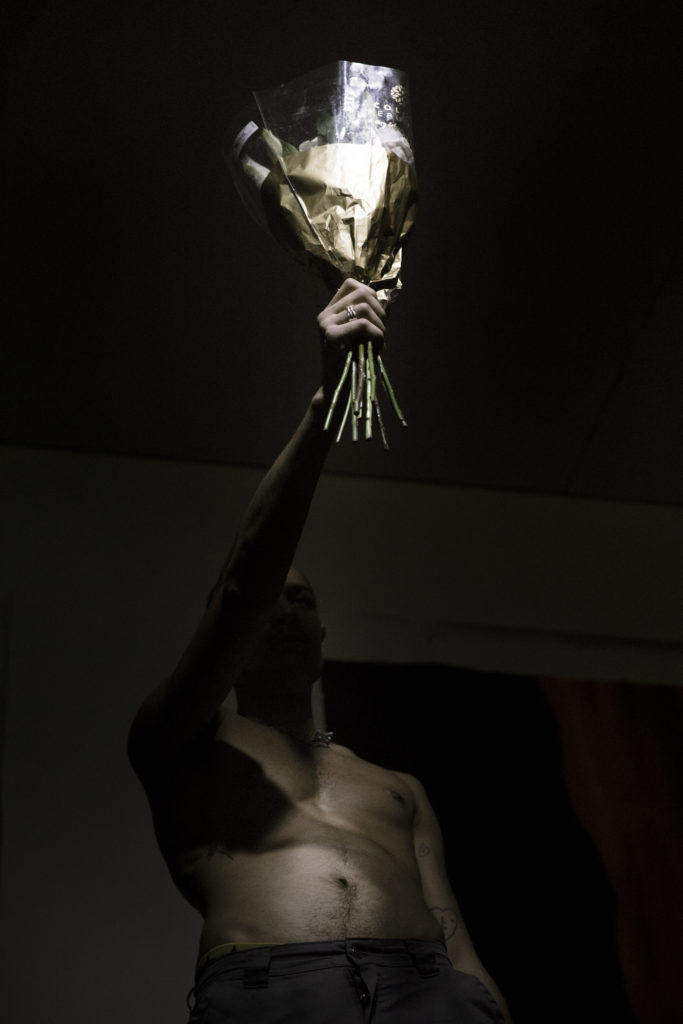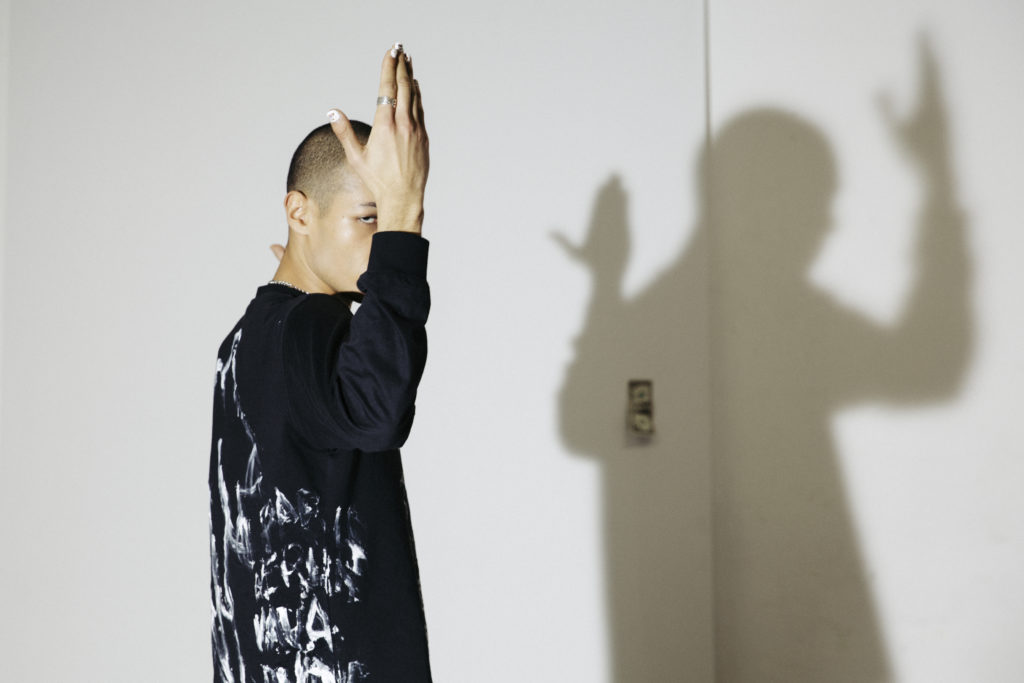Sex: Anne Imhof at the Art Institute of Chicago
by Jill Danto

Berlin: in the recent past, it has been marked as a cultural capital within the contemporary art world. Though I have never been to the city, its image appears to be a utopianism that was dreamt in response to the darker sides of its history. After World War II, the thematics of German art ranged from Socialist Realism in the communist East, to the rise of Conceptualism and other international trends in the West. After the wall fell, and Germany became a still grief-struck yet united force, Berlin became the hot spot as it is known today.
There is an estimated 20,000 practicing artists in the city alone. So how is it that Anne Imhof has risen to fame so cataclysmically, becoming both definitional to contemporary German art, as well as an international icon? Like a rocket in an unstoppable mission to the moon, she has a team of collaborators—her superstars—who have allowed her to go from having her first solo show in 2012, to winning the Golden Lion at the Venice Biennale in 2017. During her short time as an active artist, she has constructed three multi-venue operas, and a slew of other ventures with the help of remarkable talents from her home base to the wider world. What led her to a Chicago-debut is equivalent to a marathon within the span of a second.
Perhaps a history of Berlin is a bad place to start, given that Imhof is from Gießen, a college town in central Germany near Frankfurt, about five hours from the capital. Known for Mathematikum, a science museum with interactive exhibits, and the Castelo Gleiberg, a Medieval castle, the landmarks of her hometown can be seen interpretively through her panoramic installations and technically advanced performance works. While often questioning the imbrication of technology, commodity fetishism, and media-influenced isolationism, the place of her performances—the constructed architecture of art institutions—provides a spectral home, lapsing the real with a perceived memory palace.
In the words of Gaston Bachelard, “Indeed, dreams go back so far into an undefined, dateless past that clear memories of our childhood home appear to be detached from us. Such dreams unsettle are daydreaming and we reach a point where we begin to doubt that we ever lived where we lived.”1 Anne Imhof is foremost considered an international artist, but even under layers of an aesthetic daydream, there are notions of home, or a disbelief in that notion, which parse through the artist’s minimalistic sensibility. Every item is loaded with signifiers, and every step is a reenactment of a step that is taught throughout a life. In other words, nature and nurture both haunt at the same pace.
In an interview with internationally-renowned stylist Lotta Volkova, Imhof noted that she is in a phase of transition, moving constantly between Berlin, Frankfurt, and occasionally New York City. They bonded over this feeling, in Volkova’s words being, “everywhere and nowhere at the same time.”2 Their dialogue confirms a growing trend amongst artists, and specifically performance-based artists: the demand to be nomadic. Given Imhof’s underlying critique of neoliberalism, subjecting oneself to this surreal demand may seem to undo the potential degree of any possible criticality. Yet, Imhof’s submission to the virtual community that her work questions—actively allowing social media to inform the formal qualities which are archived online forever, as well as the image circulation which never ceases—while being visibly present at each of her performances, has allowed for this demand to roll into the oeuvre beautifully.
In essence, unlike how performance art has been defined within art curriculums since the 1970s, Imhof is not exactly the performer in her performances—instead, the artist primarily operates as a producer. She can be seen watching the work unfold amongst the crowd, with a heavier hand in the creation behind the scenes. The object in question is never her own body, but a construction of collaborators whose both intentional and non-intentional affect appear to predict the futures of an apathetic community.

In her latest work, Sex, performed in its second iteration at the Art Institute of Chicago, Imhof maps contemporary politics and aesthetics into something that looks like a four-hour opera, but evolves into a romantic mythology. Performers are adorned with Balenciaga, images of Alexandria Ocasio-Cortez, the Grateful Dead, Adidas track pants, normcore gothic attire, and the occasional polo all in the same space; each of them acting steadily disaffected by all movements made. Though this is one of three parts of what will be considered a single vision, the mysterious nature of Imhof and her co-artists likely being the only people to see the entirety of this cross-continental artwork leads me to question this: what can abstraction do to conjure emotion when toying with depersonalization? Why are the aesthetics of disdain more unifying than anything else in this moment?
Looking back to her previous endeavors, Imhof has been known to construct peculiar bodily honesty under impending hegemony. Though her practice is rooted in drawing and painting, her career began to take off with performances such as the School of the Seven Bells (2012–2015), Aqua Leo (2013), and Rage (2014-2015), all of which combined aspects of sculptural practice, live durational performance, and gestures of minor emotionlessness within gallery walls. The popularity around her ephemeral installations has allowed larger institutions to take note, and summoned the opportunity to expand while bringing each of her previous performances inwards towards the creation of her first large-scale, multi-venue performance, Angst (2016). Angst was also to be her first foray into the form that she is most known for: exhibition-as-opera.
In Latin, opera translates to, “work,” both in the sense of labor involved and the result produced. Pushing performers to their limits, as well as an audience patiently rotating through the activation of the work, Imhof uses opera not only as a test of physical ability but also as a test to its monumental cultural tradition, questioning what deserves to be celebrated or recognized on a larger scale. In placing a mirror in front of consumerism and popular culture through iconographic mythology—such as staging live falcons in the role of the Prophets for Angst , while adorning the space with Pepsi and Diet Coke—Imhof locates a framing device through which chaos can ensue. Her next large-scale performance would be Faust (2017), performed at the Venice Biennale within the German Pavilion. Transitioning between performers reclining under a glass floor, sitting at the edge of a twenty-foot tall gate at the border of the premises, and occasionally walking around the space amongst onlookers, the work took a further turn towards abstraction. Instead of blatant branding, the interest turned towards communication. Relating to the title of the work, Faust takes on the German legend of selling one’s soul to the devil by speculating how an obsession with power and excess may be born anew through means that render our bodies as a material commodity, rather than an operational point of empathy.
The trajectory seems clear, and even after taking a year break between Faust and Sex, the similarities that unite each of her pieces seem to culminate into this most recent performance to date. Each iteration of Sex is approximated to be around four hours long, touring the world from its debut at the Tate Modern, London; onto the Art Institute of Chicago, notably curated by Dittmer Curator of Contemporary Art, Hendrik Folkerts; and ending at Castello di Rivoli Museo d’Arte Contemporanea, Rivoli-Turin. Alongside frequent collaborators Billy Butheel and Eliza Douglas, and a slew of models and actors including Ian Edmonds, Sacha Eusebe, Josh Johnson, Enad Marouf, Stine Omar, Nomi Ruiz, and Kizito Sango, Imhof provides her most complex work to date.
While hearkening back to symbols used throughout her previous performances—such as a falcon statue as an illusion Angst , the mattresses installed throughout the gallery are ever-present in each of her operas to date—Sex finds further footing between worlds, this time using binaries as a symbolic methodology to splice open and collapse any semblance of order. At the Art Institute, the pier that tears the room into East versus West, dark versus light—and through interaction; male versus female, inside versus outside, life versus death—remains only partially used, akin to the installation surrounding the performers. Modelos sit unopened. Kink gear is used as a frame rather than a promise of pleasure. Mere suggestions. The performance unfolds amid strobe lights, slow drags around the gallery, trust falls, texting, vaping, grunge music, spoken word, and a whole lot of La Croix in a kiddie pool.

Upon leaving one of the performances of Sex, I felt either emptied or still too full of Imhof. It is not that I felt fucked, as the title of the opera may suggest, but rather more comfortable within my prior claustrophobic-state. Within the context of the exhibition, I made a home for myself and felt at peace with the four hours of endurance that led me to stand without leaving. Home is not necessarily made of materialisms, but instead a willingness to let it take a person in each night.
Somewhere, perhaps in accordance with other cinematically-inclined live endeavors that are increasing in mainstream popularity (such as work by artists Brendan Fernandes, Tino Sehgal, and the most recent phenomenon of Sun & Sea within the Lithuanian Pavilion of the Venice Biennale), the new notion of home takes place in a non-space past where dreaming can lead. The disbelief in ever having a home is more comforting than the baggage that a domestic life may carry. There are some who may argue that this is of generational distinction—that the smartphone leads to an addiction to instant gratification—yet, there are always exceptions.
Counter-cultural movements have provided an escape from the trappings of a conventional life throughout history, and leaning against a wall in a club, body clinging to an ambient shoegaze thump, is not a new pastime. Each day I hear more people longing to move to Berlin, or a place like it, teeming with artists and opportunity. The truth is, the next Berlin is nowhere. As explored in Ann Cvetkovich’s Depression: A Public Feeling, isolation is less associated with a medical condition and is now more of a culturally unifying force. Unification does not happen under order or categorization; unification will always be unsettled. For Imhof, the prescription to be filled is how to get an audience together to realize that nothing will be realized.
Anne Imhof: Sex ran at the Art Institute of Chicago from May 30 – July 7, 2019.
- Gaston Bachelard, La Poetique de l’espace (Paris: Presses Universitaires de France, 1958); trans. Maria Jolas, The Poetics of Space (New York: Onion Press, 1964); reprinted (Boston: Beacon Press, 1969) 58.
- Interview Magazine, “Anne Imhof is Creating Hard-Core Performance Pieces That Speak to the Anxietiesof a New Generation.” Online.